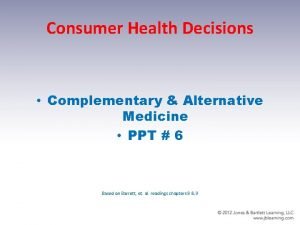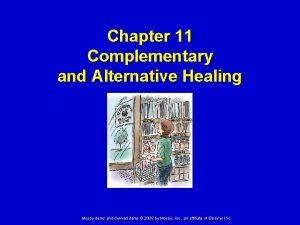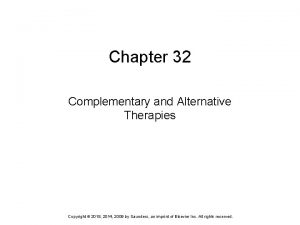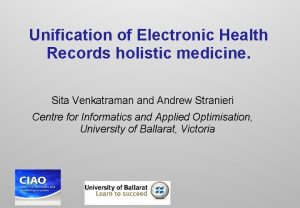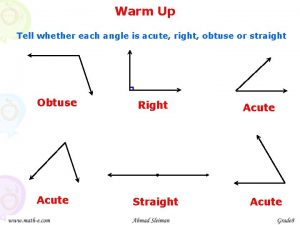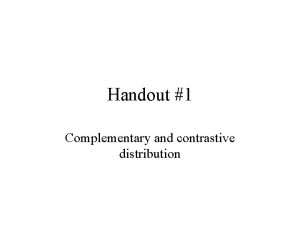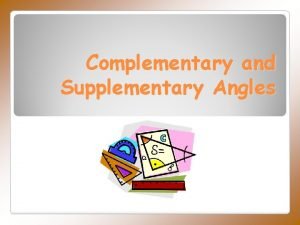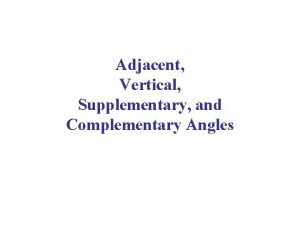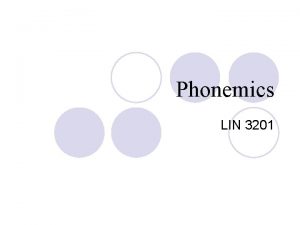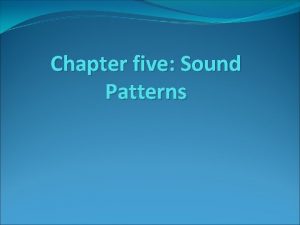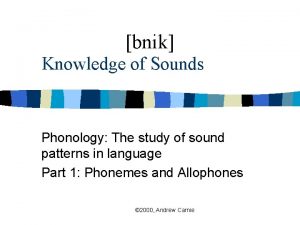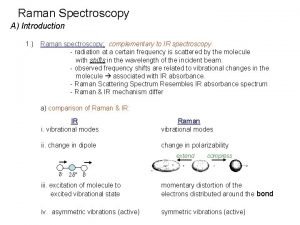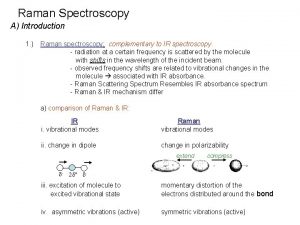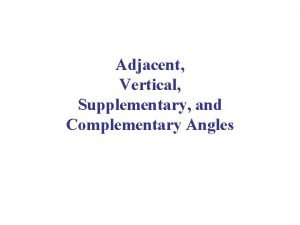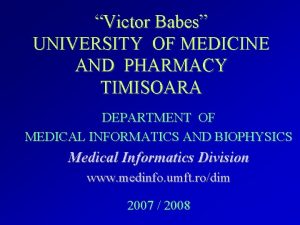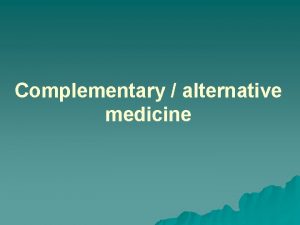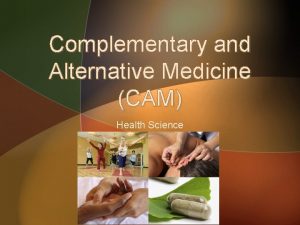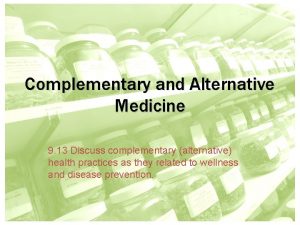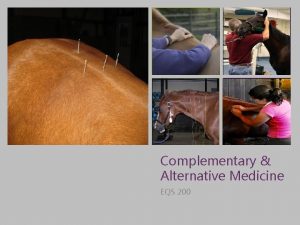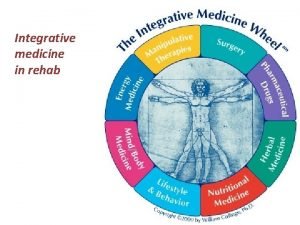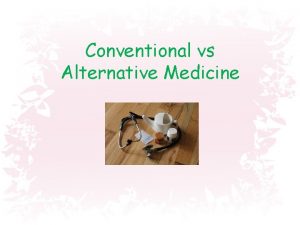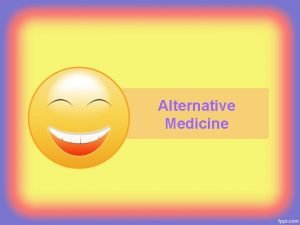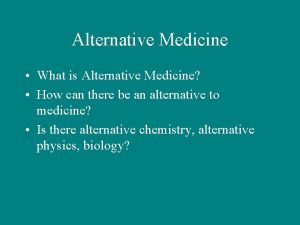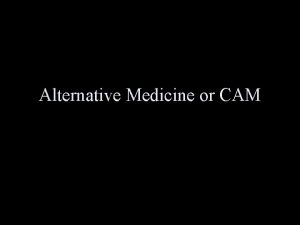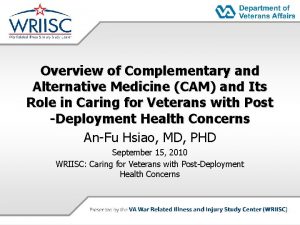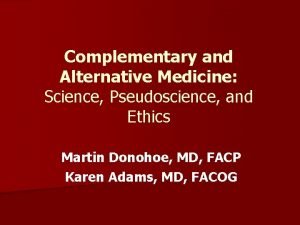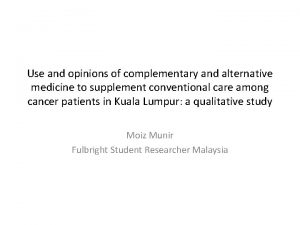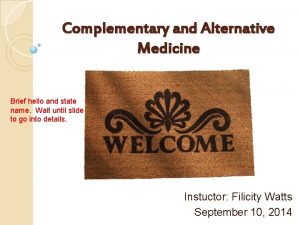Complementary alternative medicine What is complementary and alternative





















- Slides: 21

Complementary / alternative medicine

What is complementary and alternative medicine (CAM)? u It is a group of diverse medical and health care systems, practices and products that are not presently considered to be part of conventional medicine.

Are complementary medicine and alternative medicine different from each other?

Yes, they are different

u Complementary medicine is used together with conventional medicine. An example of a complementary therapy is using aromatherapy to help lessen a patient’s discomfort following surgery. u Alternative medicine is used in place of conventional medicine. An example of an alternative therapy is using a special diet to treat cancer instead of undergoing surgery, radiation, or chemotherapy that has been recommended by a conventional doctor.

What are the major types of complementary and alternative medicine?

Classify CAM therapies into five categories, or domains

1. Alternative Medical Systems. e. g. Traditional Chinese Medicine and Ayurveda 2. Mind-Body Interventions. e. g. prayer, meditation, art, music, or dance. 3. Biologically Based Therapies. e. g. dietary supplements & herbal products 4. Manipulative and Body-Based Methods. e. g. chiropractic manipulation & massage 5. Energy Therapies. I. Biofield therapies. e. g. qi gong II. Bioelectromagnetic-based therapies.

Medical Herbalism

u Medical herbalism is the use of plant remedies in the prevention and treatment of illness. u Today, medical herbalism, practiced by medical herbalists, draws on traditional knowledge, but increasingly this is interpreted and applied in a modern context.

Aspects of medical herbalism 1. Herbalism takes an holistic approach. 2. Herbalists select herbs on an individual basis for each patient. 3. Herbalists aim to identify the underlying cause (e. g. stress) of a patient’s illness and to consider this in the treatment plan. 4. Herbs are used to stimulate the body’s healing capacity, to ‘strengthen’ bodily systems and to ‘correct’ disturbed body functions rather than to treat presenting symptoms directly. 5. Herbs may be used to provide long-term relief from the particular condition.

u 1. 2. One of the tenets of herbalism is that the different constituents of a herb act together in some way that has beneficial effects. These could be: Additive effect: The combined effect of two drugs is equal to the sum of their individual actions. Synergistic effect: The combined effect of two drugs is greater than the sum of the individual effects.

Conditions treated u 1. 2. 3. 4. 5. 6. 7. 8. 9. 10. Medical herbalists treat a wide range of acute and chronic conditions. e. g. Irritable bowel syndrome Premenstrual syndrome Menopausal symptoms Eczema Types of arthritis Depression Acne and other skin conditions Cystitis (Inflammation of the urinary bladder) Migraine Chronic fatigue syndrome

Herbalist’s prescriptions u Generally, a combination of several different herbs (usually 4 -6) is used in the treatment of a particular patient. u sometimes, a single herb may be given, e. g. chasteberry (vitex agnus castus) for premenstrual syndrome and dysmenorrhea. u Each patient’s treatment is reviewed regularly and is likely to be changed depending on whether or not there has been a response.

Aromatherapy

u u u 1. 2. 3. 4. Aromatherapy is therapeutic use of aromatic substances extracted from plants. The most important group of these substances is the essential oils. How essential oils are obtained ? Distillation Enfleurage Solvent extraction Expression

Aspects of aromatherapy 1. 2. 3. 4. Aromatherapists believe that essential oils can be used not only for the treatment and prevention of disease, but also for their effects on mood and emotion. Aromatherapy is claimed to be an holistic therapy. Aromatherapists believe that the constituents of essential oils work synergistically. Essential oils are described not only with reference to reputed pharmacological properties (e. g. antibacterial), but also by terms that are not recognized in conventional medicine (e. g. balancing, energizing).

How Essential Oils Work u Essential oils are believed to act both by exerting pharmacological effects following: 1. Absorption into the circulation. 2. The effects of their odor on the olfactory system.

Conditions treated Aromatherapy is widely used as an approach to relieving stress, and many essential oils are claimed to be ‘relaxing’. u Many aromatherapists also claim that essential oils can be used in the treatment of a wide range of conditions. For example: digestive problems, eczema, headaches, insomnia. u Aromatherapy is also used in a variety of conventional healthcare settings, such as mental health units and in specialized units caring for patients with HIV/AIDS, physical disabilities and severe learning disabilities. u

Ways of Using Essential Oils 1. 2. 3. 4. Inhaling through vaporization Bathing Compress Massage

Special considerations u Some oils should be avoided by people with certain conditions, such as: 1. High blood pressure 2. Epilepsy 3. pregnancy
 Medicine ppt
Medicine ppt Chapter 11 complementary and alternative medicine
Chapter 11 complementary and alternative medicine Chapter 32 complementary and alternative therapies
Chapter 32 complementary and alternative therapies Alternative medicine ehr
Alternative medicine ehr Tell whether each type of angle is right acute or obtuse
Tell whether each type of angle is right acute or obtuse Two nonadjacent angles formed by two intersecting lines
Two nonadjacent angles formed by two intersecting lines Contrastive and complementary distribution
Contrastive and complementary distribution Angle 1 and angle 2 are supplementary
Angle 1 and angle 2 are supplementary Adjacent angkes
Adjacent angkes Free variation and complementary distribution
Free variation and complementary distribution Distinctive features phonology
Distinctive features phonology Complementary distribution examples
Complementary distribution examples Free variation and complementary distribution
Free variation and complementary distribution Why are raman and ir complementary
Why are raman and ir complementary Why are raman and ir complementary
Why are raman and ir complementary Adjacent and complementary angles
Adjacent and complementary angles Angles a and b are complementary
Angles a and b are complementary Angle klm and angle mln are complementary
Angle klm and angle mln are complementary Universitatea de medicina si farmacie victor babes
Universitatea de medicina si farmacie victor babes School of public health and preventive medicine
School of public health and preventive medicine Medicine wheel colors in order
Medicine wheel colors in order Mrbs scholarship
Mrbs scholarship
